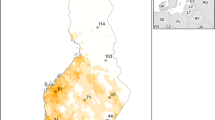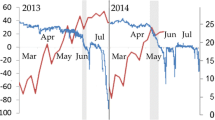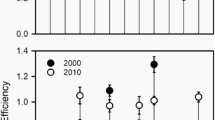Abstract
Leakage of nutrients from farmland to freshwater and marine environments results in fertilization that increases primary production with cascading effects in the ecosystem. Leakage of fertilizers may initially increase availability of food for primary and secondary consumers, although part of this effect may subsequently be followed by a reduction in food abundance caused by hypoxia. We hypothesized that leakage of nutrients from farmland increased primary and secondary production and subsequently the population size of waterbirds. The amount of phosphorus in the marine environment in Denmark during 1975–2010 increased with fertilizer use on farmland and this effect was stronger when winter precipitation was high. Leakage of fertilizer had ecosystem effects on phytoplankton, zooplankton, and ultimately biodiversity in the marine environment. We found linear relationships between fertilizer use and population size of breeding and wintering waterbirds, with additional quadratic relationships with fertilizer use and linear effects of temperature. The linear effect of fertilizer use depended on the diet of waterbirds with stronger effects in herbivorous and piscivorous species than in species eating benthos. These findings have implications for management of waterbird populations because a reduction in fertilizer use should result in increasing populations of herbivores and piscivores.





Similar content being viewed by others
References
AEWA. 2008. Report on the conservation status of migratory waterbirds in the agreement area. Wageningen: Wetlands International.
Baird D. 2004. Consequences of hypoxia on estuarine ecosystem function: Energy diversion from consumers to microbes. Ecol Appl 14:805–22.
Bakker ES, Van Donk E, Declerck SAJ, Helmsing NR, Hidding B, Nolet BA. 2010. Effect of macrophyte community composition and nutrient enrichment on plant biomass and algal blooms. Basic Appl Ecol 11:432–9.
Beman JM, Arrigo KR, Matson PA. 2005. Agricultural runoff fuels large phytoplankton blooms in vulnerable areas of the ocean. Nature 434:211–14.
Bloom AJ, Chapin FSIII, Mooney HA. 1985. Resource limitation in plants—an economic analogy. Ann Rev Ecol Syst 16:363–92.
Breitburg D. 2002. Effects of hypoxia, and the balance between hypoxia and enrichment, on coastal fishes and fisheries. Estuaries 25:767–81.
Bryhn AC, Jeménez A, Mateos A, Rios-Insua S. 2009. Multi-attribute analysis of trophic state and waterfowl management in Ringkøbing Fjord, Denmark. J Environ Manage 90:2568–77.
Cappelen J, Ed. 2012. Denmark—DMI Historical Climate Data Collection 1768–2012—with Danish Abstracts No. 13–02. Copenhagen: DMI.
Cardinale M, Modin J. 1999. Changes in size-at-maturity of Baltic cod (Gadus morhua) during a period of large variations in stock size and environmental conditions. Fish Res 41:285–95.
Carstensen J, Daniel JC, Bonsdorff E, Gustafsson BG, Hietanen S, Janas U, Jilbert T, Norkko A, Norkko J, Reed DC, Slomp CP, Timmermann K, Voss M. 2014. Hypoxia in the Baltic Sea: biogeochemical cycles, benthic fauna, and management. Ambio 43:26–36.
Chapin FSIII, Vitousek PM, Van Cleve K. 1986. The nature of nutrient limitation in plant communities. Am Nat 127:48–58.
Chatfield C. 1999. The analysis of time-series: an introduction. 5th edn. Boca Raton: Chapman and Hall.
Cohen J. 1988. Statistical power analysis for the behavioral sciences. 2nd edn. Hillsdale: Lawrence Erlbaum.
Conley DJ, Carstensen J, Ærtebjerg G, Christensen PB, Dalsgaard T, Hansen JLS, Josefson AB. 2007. Long-term changes and impacts of hypoxia in Danish coastal waters. Ecol Appl 17:S165–84.
Cramp S, Perrins CM. 1977–1994. The Birds of the Western Palearctic, Vols. 1–9 Oxford: Oxford University Press.
Diaz RJ, Rosenberg R. 2008. Spreading dead zones and consequences for marine ecosystems. Science 321:926–9.
Draper NR, Smith H. 1981. Applied regression analysis. 2nd edn. New York: John Wiley.
Duce RA, LaRoche J, Altier K. 2008. Impacts of atmospheric nitrogen on the open ocean. Science 320:893–7.
Duus K, Zinglersen E. 2000. Geografistatistik 2000. Copenhagen: Geografforlaget.
Eriksson Hägg H, Humborg C, Mörth C-M, Medina MR, Wulff F. 2010. Scenario analysis on protein consumption and climate change effects on riverine N export to the Baltic Sea. Environ Sci Technol 44:2379–85.
EU. 2000. EU Water Framework Directive. http://ec.europa.eu/environment/water/water-framework/index_en.html. Accessed 6 May 2014.
Foster BL, Tilman D. 2003. Seed limitation and the regulation of community structure on oak savanna grassland. J Ecol 91:999–1007.
Galloway JN, Townsend AR, Erisman JW. 2008. Transformation of the nitrogen cycle: recent trends, questions, and potential solutions. Science 320:889–92.
Garamszegi LZ, Møller AP. 2010. Effects of sample size and intraspecific variation in phylogenetic comparative studies: a meta-analytic review. Biol Rev 85:797–805.
Heldbjerg H, Lerche-Jørgensen M, Eskildsen A. 2011. Overvågning af de almindelige fuglearter I Danmark. Copenhagen: Dansk Ornithologisk Forening.
Hjorth M, Josefsen AB, Eds. 2010. Marine områder 2008. Faglig rapport fra DMU nr. 760. Aarhus: Danmarks Miljøundersøgelser, Aarhus Universitet.
Hooper DU, Chapin FSIII, Ewel JJ, Hector A, Inchausti P, Lavorel S, Lawton JH, Lodge DM, Loreau M, Naeem S, Schmid B, Setälä H, Symstad AJ, Vandermeer J, Wardle DA. 2005. Effects of biodiversity on ecosystem functioning: a consensus of current knowledge. Ecol Monogr 75:3–35.
IPCC. 2007. Climate Change 2007. Cambridge: Cambridge University Press.
JMP. 2012. JMP version 10.0. Cary: SAS Institute Inc.
Karlson K, Rosenberg R, Bonsdorff E. 2002. Temporal and spatial large-scale effects of eutrophication and oxygen deficiency on benthic fauna in Scandinavian and Baltic waters: a review. Oceanogr Mar Biol 40:427–89.
Koerselman W, Meuleman AFM. 1996. The vegetation N: P ratio: a new tool to detect the nature of nutrient limitation. J Appl Ecol 33:1441–50.
Laursen K, Blew J, Eskildsen K, Günther K, Hälterlein B, Kleefstra R, Lüerssen G, Potel P, Schrader S. 2010. Migratory waterbirds in the Wadden Sea 1987–2008. Wilhelmshaven: Common Wadden Sea Secretariat.
Laursen K, Møller AP. 2014. Long-term changes in nutrients and mussel stocks are related to numbers of breeding eiders Somateria mollissima at a large Baltic Colony. PLoS One 9(4):e95851.
Lindström J, Forchhammer M. 2010. Time-series analyses. In: Møller AP, Fiedler W, Berthold P, Eds. Climate change and birds. Oxford: Oxford University Press. p 57–66.
Mee L. 2006. Reviving dead zones. Sci Am 295:78–85.
Møller AP, Flensted-Jensen E, Mardal W. 2006. Rapidly advancing laying date in a seabird and the changing advantage of early reproduction. J Anim Ecol 75:657–65.
Møller AP, Flensted-Jensen E, Mardal W. 2007. Agriculture, fertilizers and life history of a coastal seabird. J Anim Ecol 76:515–25.
Møller AP, Rubolini D, Lehikoinen E. 2008. Populations of migratory bird species that did not show a phenological response to climate change are declining. Proc Natl Acad Sci USA 105:16195–200.
Møller AP, Flensted-Jensen E, Klarborg K, Mardal W, Nielsen JT. 2010. Climate change affects the duration of the reproductive season in birds. J Anim Ecol 79:777–84.
Neter J, Kutner MH, Nachtsheim CJ, Wasserman W. 1996. Applied linear statistical models. Chicago: Irwin.
Newton I. 1998. Population limitation in birds. Amsterdam: Academic Press.
Nielsen E, Richardson K. 1996. Can changes in the fisheries yield in the Kattegat be linked to changes in primary production? ICES J Mar Sci 53:988–94.
Nixon SW. 1992. Quantifying the relationship between nitrogen input and the productivity of marine ecosystems. In: Proc Adv Marine Technol Conf, pp 57–83.
Nixon SW, Buckley BA. 2002. “A strikingly rich zone”: Nutrient enrichment and secondary production in coastal marine ecosystems. Estuaries 25:782–96.
Pearson TH, Rosenberg R. 1992. Energy-flow through the SE Kattegat: a comparative examination of the eutrophication of a coastal marine ecosystem. Neth J Sea Res 28:317–34.
Peters SWM, Eleveld M, Pasterkamp R, van der Woerd H, Devolder M. 2005. Atlas of chlorophyll-a concentration in the North Sea based on MERIS imagery 2003. Amsterdam: Vrije Universiteit Amsterdam.
Philippart CJM, Beukema JJ, Cadée GC, Dekker R, Goedhart PW, van Iperen JM, Leopold MF, Herman PMJ. 2007. Impacts of nutrient reduction on coastal communities. Ecosystems 10:95–118.
Richardson K, Heilmann JP. 1995. Primary production in the Kattegat—past and present. Ophelia 41:317–28.
Rosenberg R. 1985. Eutrophication: The future marine coastal nuisance. Mar Poll Bull 16:227–31.
Rosenberg R, Agrenius S, Hellman B, Nilsson HC, Norling K. 2002. Recovery of marine benthic habitats and fauna in a Swedish fjord following improved oxygen conditions. Mar Ecol Progr Ser 234:43–53.
Rosenthal R. 1994. Parametric measures of effect size. In: Cooper H, Hedges LV, Eds. The handbook of research synthesis. New York: Russell Sage Foundation. p 231–44.
Sæther BE, Sutherland WJ, Engen S. 2004. Climate influences on avian population dynamics. In: Møller AP, Fiedler W, Berthold P, Eds. Birds and climate change. Adv Ecol Res 35:185–209. Amsterdam: Elsevier.
Steckbauer A, Duarte CM, Carstensen J, Vaquer-Sunyer R, Conley DJ. 2011. Ecosystem impacts of hypoxia: thresholds of hypoxia and pathways to recovery. Environ Res Lett 6:025003.
Tilman D, Reich PB, Knops J, Wedin D, Mielke T, Lehman C. 2001. Diversity and productivity in a long-term grassland experiment. Science 294:843–5.
Tyrrell T. 1999. The relative influences of nitrogen and phosphorus on oceanic primary production. Nature 400:525–31.
Vorisek P, Klvanova A, Wotton S, Gregory RD. 2010. A best practice guide for wild bird monitoring schemes. Bruxelles: European Union.
Acknowledgments
NOWAC provided the impetus for this research. A. Fox kindly provided constructive suggestions.
Author information
Authors and Affiliations
Corresponding author
Additional information
Author Contribution
Conceived of or designed study: APM, KL. Performed research: APM, EFJ, KL, WM. Analyzed data: APM. Contributed new methods or models: APM. Wrote the paper: APM.
Electronic supplementary material
Below is the link to the electronic supplementary material.
Rights and permissions
About this article
Cite this article
Møller, A.P., Flensted-Jensen, E., Laursen, K. et al. Fertilizer Leakage to the Marine Environment, Ecosystem Effects and Population Trends of Waterbirds in Denmark. Ecosystems 18, 30–44 (2015). https://doi.org/10.1007/s10021-014-9810-4
Received:
Accepted:
Published:
Issue Date:
DOI: https://doi.org/10.1007/s10021-014-9810-4




